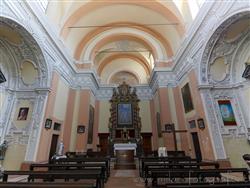|
Caravaggio (Bergamo, Italy): Church of Santa Elisabetta
|
|
|
Show an other place around Milan worth a visit: |
 The Church of Santa Elisabetta, or, more precisely, Church of the Visitation of Mary to Elizabeth, was originally part of the complex of the former Augustinian monastery, formerly monastery of the Visitadines of the order of St. Francis de Sales, now part of the parish house. The monastery was suppressed in 1805. The church was subsequently the subject of controversy as to who owned it. Today it is the property of the parish. The Church of Santa Elisabetta, or, more precisely, Church of the Visitation of Mary to Elizabeth, was originally part of the complex of the former Augustinian monastery, formerly monastery of the Visitadines of the order of St. Francis de Sales, now part of the parish house. The monastery was suppressed in 1805. The church was subsequently the subject of controversy as to who owned it. Today it is the property of the parish.
The current church was built starting from 1626 on a design by Fabio Mengoni(or Mengone, according to other sources) in place of a pre-existing church. The work progressed slowly, so much so that it was consecrated only in 1674 and was never actually finished, especially on the outside, so much so that the facade still appears unfinished today.
The position of the church does not allow to adequately appreciate its external aspect, so much so that it is easy not to notice that the facade has remained unfinished and many details are absent, starting with the tympanum on the top. However, it is very elegant and well-proportioned, marked by four pilasters and crowned by an elaborate frame. The pilasters end with four refined Ionic capitals with a hollowed abacus.
The entrance, in the center, is framed by a monumental portal with a broken pediment. Above it, in the upper part of the façade, there is a large rectangular window that guarantees good interior lighting.
The interior of the church is rectangular, almost square, with the two side chapels as if to suggest a Greek cross structure. The cover is barrel vault. The walls are marked by pilasters supporting a thick entablature decorated with an alternation of cherub heads and plant elements divided into sections separated by miniature pilasters.
The presbytery is occupied by an inlaid and gilded wooden altar dominated by a large wooden altarpiece with an architectural structure centered on two large twisted columns that support a pediment that contains the dedication to St. Elizabeth. All enriched by statues of cherubs, cherub heads, festoons. The altarpiece is represented by a Visitation of antiquarian origin. On the side walls there are two recently restored paintings: The Mass of St. Bernard and the Martyrdom of Antonio Maria Ripari.
The two side chapels have the same structure, characterized by a barrel vault and rich decorations in white stucco. We recognize frames and panels probably destined to house paintings but which instead remained empty.
In both chapels the altar is surmounted by a large baroque retable in wood and stucco with an architectural structure, where two columns support a composite broken pediment. In the chapel on the left, which according to the inscription on the pediment of the retable should be dedicated to Mary the Consoler, there is an altarpiece depicting Saint Anthony of Padua, in the one on the right the altarpiece depicts a Virgin Mary with Child between the Saints Rocco and Sebastian. Both altarpieces come from Caravaggio's churches that were destroyed.
The church has a so-called "internal church", i.e. a second hall behind the apse, separate from the one open to the public and reserved for nuns. Of comparable size to the public part, the part reserved for the nuns is however almost devoid of decorations, except for some stucco decorations on the ceiling. The lower part of the walls, however, is occupied by a precious solid wood choir.
Categories: Places of historical value of artistic value
Via Bernardo da Caravaggio, ., 24043 Caravaggio BG |
Further pictures of Church of Santa Elisabetta in the section Photography |